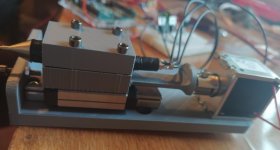Hello,
I'm not an mechanical engineer (despite being fascinated by this field) and I need some advice. I'm creating a stippling machine, now it's working but for linear guiding I use linear carriage, which I think is overkill as only thing it does is keeping it from spinning and guiding the needle up and down. Take a look in the photo below.
My question is how can I achieve the same guiding (with spinning prevention) motion cheaper and preferably with less friction? I know that carriage has little to none friction, but I want my contraption to have small weight thus i'm thinking something from nylon without lubricant would have less friction or maybe a better expression less stickiness. But I have no idea how it should look like. I've seen these plastic guides, but they are expensive and im thinking maybe local machinist could make me some dovetail guide-ways or something like that.
Simas
I'm not an mechanical engineer (despite being fascinated by this field) and I need some advice. I'm creating a stippling machine, now it's working but for linear guiding I use linear carriage, which I think is overkill as only thing it does is keeping it from spinning and guiding the needle up and down. Take a look in the photo below.
My question is how can I achieve the same guiding (with spinning prevention) motion cheaper and preferably with less friction? I know that carriage has little to none friction, but I want my contraption to have small weight thus i'm thinking something from nylon without lubricant would have less friction or maybe a better expression less stickiness. But I have no idea how it should look like. I've seen these plastic guides, but they are expensive and im thinking maybe local machinist could make me some dovetail guide-ways or something like that.
Simas





